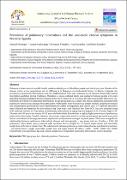| dc.contributor.author | Florence, Tushabe | |
| dc.contributor.author | Samuel, Mwesige | |
| dc.contributor.author | Annet, Nankwanga | |
| dc.contributor.author | Ivan, Kasamba | |
| dc.contributor.author | Ruth, Kateeba | |
| dc.date.accessioned | 2023-08-21T15:27:44Z | |
| dc.date.available | 2023-08-21T15:27:44Z | |
| dc.date.issued | 2022 | |
| dc.identifier.citation | Mwesige, S., Nankwanga, A., Tushabe, F., Kasamba, I., & Kateeba, R. (2022). Prevalence of pulmonary tuberculosis and the associated clinical symptoms in Western Uganda. Int. J. Life Sci. Res. Arch, 3(1), 155-162. | en_US |
| dc.identifier.uri | https://ir.sun.ac.ug//handle/123456789/84 | |
| dc.description.abstract | Abstract
Pulmonary tuberculosis is a public health problem affecting over 5.8 million people worldwide per year. Burden of the disease varies across populations due to differences in biological and behavioral factors. In Western Uganda, the prevalence of pulmonary tuberculosis was not established and there was continued use of a biased clinical tuberculosis description guideline during treatment. Therefore, a cross-sectional study was conducted among people ≥12 years attending Buhinga hospital in Western Uganda from April to June 2019 to achieve the following specific objectives; (1)-Determine prevalence of pulmonary tuberculosis by age group and sex, 2-Assess the clinical symptoms associated with pulmonary tuberculosis amongst the participants. Participants were recruited by simple random sampling technique and standardized questionnaire were administered to obtain demographic and clinical data. 379 sputum specimens were collected and tested for M. tuberculosis using Gene X-pert and Classical Real Time PCR. Data was analyzed using SPSS software version 13. Prevalence of pulmonary tuberculosis by age group was highest in 20-29 years, high in 30-39 years and ≥50 years and least in 10-19 years old individuals. Females had a slightly higher prevalence of pulmonary tuberculosis than males. Youthful behavior of active participation in social activities and advanced age health associated factors contributed to the high prevalence of pulmonary tuberculosis amongst the participants. There was no significant relationship between pulmonary tuberculosis disease and demography; - age group and sex (P-value = 0.24). All pulmonary tuberculosis cases presented with persistent fevers, coughs for ≥ 2 weeks, night sweats and noticeable weight loss in the hierarchical order. The relationship between pulmonary tuberculosis disease and clinical symptoms; - persistent fevers, cough, noticeable weight loss and night sweats (P-values; <0.001, <0.001, 0.001 and <0.001 respectively) was significant. Age and clinical symptoms are important pulmonary tuberculosis control hotspots. | en_US |
| dc.description.sponsorship | N/A | en_US |
| dc.language.iso | en | en_US |
| dc.publisher | International Journal of Life Science Research Archive | en_US |
| dc.subject | PTB; Age group; Sex; Clinical symptoms; Prevalence | en_US |
| dc.title | Prevalence of pulmonary tuberculosis and the associated clinical symptoms in Western Uganda | en_US |
| dc.type | Article | en_US |

